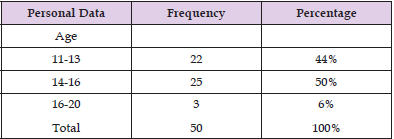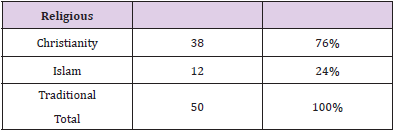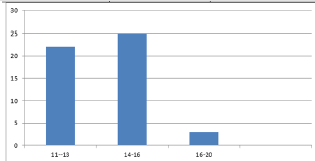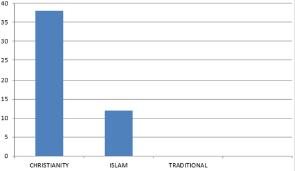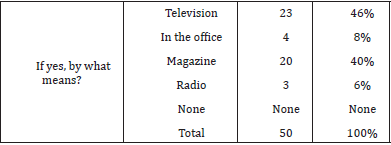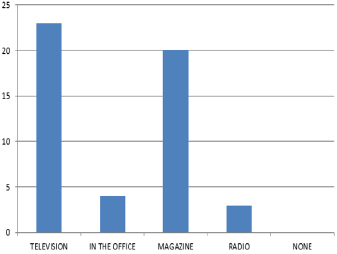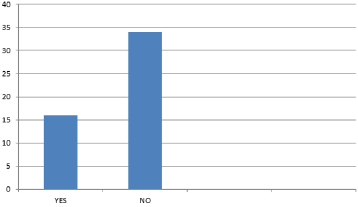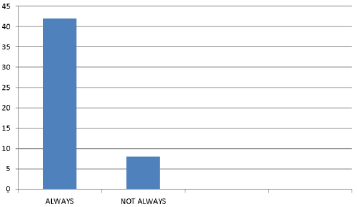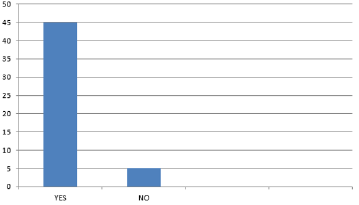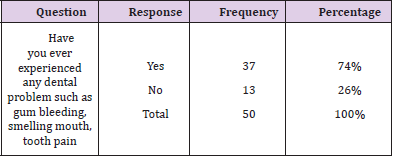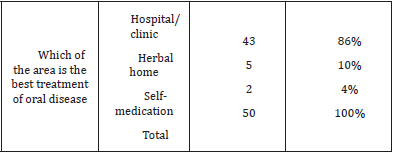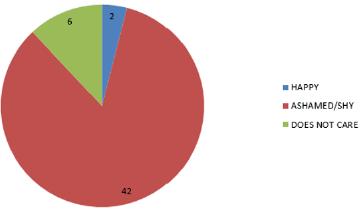Abstract
Halitosis or mostly commonly bad breath is term used to describe noticeably unpleasant breathing. Halitosis can be important social problem. The standard dental treatment and mouth wash that are often recommended provide only temporarily relief the smell emanating from the mouth. The objectives of this research are to identify the causes of halitosis among secondary student in Ijero Ekiti local government area of Ekiti state, Nigeria and to find out the Effects of halitosis among secondary student in the study area. The study area is Secondary schools in Ijero Ekiti. There are two major secondary schools which are Doherty memorial grammar school and Ijero High School. Students at Mercy Model Private School were excluded from this study as the researcher focused on public secondary school because of prevailing factors. Two public schools were selected for this study namely, Doherty memorial grammar school and Ijero High School. The population of the study area is 2900 for Ijero High School while 3200 for Doherty Memorial grammar school which gave us a total of 6100 students as at the time of this research work. Author used stratified sampling technique where in the population was divided in to two strata [Junior and senior category], where in 25 students were randomly selected from the junior category in each school. Hence, a total of 100 respondents were drawn for the study. Questionnaire was adopted as the instrument for data collection, the instrument was tested through a pilot study with result at 0.91. Results were analyzed using simple percentage, graphs and tables.
Keywords: Problems; Dental Health; Oral Hygiene; Health Facility
Introduction
The term halitosis is derived from the Latin word Halitu, meaning breath and greek suffix “osis” mean condition. Halitosis is defined as a noticeable unpleasant odour that emanates from the mouth which is objectionable to others. it is a medico_ social problem that affect a significant number of people around the world [1]. Halitosis or mostly commonly bad breath are term used to describe noticeably unpleasant of our exhale in breathing. Halitosis can be important social problem in which the standard dental treatment and mouth wash that are often recommended provide only temporarily relief the smell is from an oral source due to bacterial activities [2]. Halitosis is document to be the third most frequent reasons for seeking dental aid following tooth decay and periodontal disease many studies on self-reported halitosis have stressed that the problem of bad breath is often not self-perceive [3]. Some cases, there is reduced chance of self-detection of oral mal-odor because the path between the inhaled and exhale air is diverge (while exhale air travel horizontally, inhaled air travel primarily vertically).the information fact is that many people do not know that they have a break problem unless someone directly inform them [4]. Some bad breath, however, are considered to be somehow normal one example is “morning mouth” which is as a result of change the condition of mouth during sleeping.
During the day ,saliva washes decaying food and odor out of the mouth. Less saliva is produced at night this the mouth become dry and dead cell sticks to tongue and cell for food ,they produce foul odor [5]. The most common location for mouth related halitosis is the tongue. Tongue bacteria produce mal-odor and fatty acid and count for about 80 to 90 percent of all case of mouth related bad breath. Large quantities of naturally occurring bacteria are often found on the dorsum of the tongue, where they are relatively undisturbed by normal activities [6]. This part of the tongue is relatively dry and poorly cleaned and bacteria population can thrive on remnant of food deposit, dead epithelial cell and postnasal drip. The convoluted microbial structure of the tongue dorsum provide an ideal habitat for anaerobic bacterial ,which flourish under a continually forming tongue costing of food debris, dead, cells, postnasal drip and overlying bacteria living and dead when left on the tongue the anaerobic respiration of such bacterial can yield either the putrescent smell of in dole, skatole,methyl mercapton, alloymethyl sulfide and dimethyl [7]. There are several cause of halitosis although the main one is oral bacterial over 90 million people suffer from chronic halitosis which is medical term for bad breath in most cases halitosis originate from the gum and tongue, caused by bacterial from the decay of food parties, other debris in the mouth itself [8].
The bad breath differ during the day ,due to eating of certain food such as garlic, onions, meat, egg, smoking and alcohol consumption , since the mouth is exposed to less oxygen and is in active during the night the odour is usually worse upon awakening (morning breath). bad breath rinsing with special mouth wash .various method used to control halitosis (bad breath) such mouth spray and mouth wash may only be temporarily mask the odour created by bacteria on the tongue but cannot cure bad breath because they don’t remove the source of bad breath, in order to prevent the production of the sulfur containing compound mention above the bacteria on the tongue must be removed regularly [9]. Most people who clean their tongue use a(tongue scrappy) or a toothbrush. Halitosis has the meaning is bad breath can be form by eating of certain foods, like cooed, garlic, onions, when absorbed into our blood stream, are transferred to lungs and exhale breath will be produced as bad breath and also the breakdown of food particles in and around the teeth can increase bacteria and cause a foul odour. Suffering from some system disease such as liver and kidney, diabetic mellitus, digestive tract infection whereby cases are blocked from passing the stomach or intestines can also bring mouth odour. When the mouth is dry ,saliva production decrease leaving the mouth natural ability to clean itself impaired. Saliva is mouth’s natural mouth wash which container properties that keep the mouth clean. All these factor causes halitosis and also enlighten student about it.
Objective of the Study
a) To identify the causes of halitosis among secondary student in Ijero ekiti local government area of ekiti state, Nigeria.
b) To find out the Effects of halitosis among secondary student in Ijero ekiti local government area of ekiti state, Nigeria
Methodology
The study area is Secondary schools in Ijero Ekiti. There are two major secondary schools which are Doherty memorial grammar school and Ijero High School.
Inclusion and Exclusion Criteria
Students at Mercy Model Private school were excluded from this study as the researcher focused on public secondary school because of prevailing factors. Two public schools were selected for this study namely, Doherty memorial grammar school and Ijero High School [10-15].
Sampling Technique
The researcher adopted stratified random sampling technique to select study sample. The population of the study area is 2900 for Ijero High School while 3200 for Doherty Memorial grammar school which gave us a total of 6100 students as at the time of this research work. Author used stratified sampling technique where in the population was divided in to two strata [Junior and senior category], where in 25 students were randomly selected from the junior category in each school. Hence, a total of 100 respondents were drawn for the study. Questionnaire was adopted as the instrument for data collection, the instrument was tested through a pilot study with result at 0.91 [16-28]. Results were analyzed using simple Percentage, Graphs and Tables.
Results
Background Information about the Respondents
Tables 1-4 and Graphs 1 & 2.
Table 1: The majority of the respondent (50%) fell in age group 14- 16 years, (44%) of them are of age 11-13 years while 16- 20years of age are of (6%).
Table 3: The majority of the respondents of 76% are of Christian, 24% of them are Islamic and 18% of them are Igbo.
Table 4: 72% of the respondents are Yoruba, 10% are of Hausa, and 18% of the respondents are of Igbo.
Attitudes, Knowledge and Awareness of the People Towards Oral Health
Tables 5-14 and Graphs 3-7.
Table 5: It was gathered that 72% of the respondents have heard about oral health education while 28% are not aware.
Table 6: 23 respondents representing 46% heard about oral health education by the means of television, 4 respondents representing 8% heard in the office,20 respondents representing 40% heard through magazine, 3 respondents representing 6% heard through Radio.
Table 7: Shows that 54% of the respondents have gained from oral health education while 46% gained nothing from oral health education.
Table 8: It was gathered that 76% of the respondents clean their mouth once a day while 24% clean their mouth twice a day.
Table 10: Show that 16 respondents representing 32% are aware about fluoride in toothpaste while 34 respondents representing 68% are not aware about fluoride in toothpaste.
Table 11: It was gathered that 78% if the respondents eat sweet and snacks while 22% do not eat sweet and snacks.
Table 12: 42 respondents representing 84% always eat sweet and snacks while 8 respondents representing 16% do not eat sweet and snacks always.
Table 13: 24% of the respondents always rinse their mouth with water after eating while 76% do not rinse their mouth after eating.
Table 14: Show that 90% of the respondents knew that balanced diet including plenty fruit and vegetables are good for maintenance while 10% are not aware.
Halitosis Problem Experienced and Where Treated
Tables 15-19 and Graphs 8 & 9.
Table 15: It was gathered that 37 respondents representing 74% have experience oral health problems while 13 respondents representing 26% have not experience such.
Table 16: Shows that 86% of the respondents said hospitals/ clinic are best place for treating oral health problems, 10% of the respondents agreed that herbal home is the best place while 4% of the respondents said self-medication is the best place.
Table 17: 26 of the respondents representing 52% have visited dental clinic before while 24 respondents representing 48% have not visit the dental clinic.
Table 18: It was gathered that 94% of the respondents said they can advise their fellow colleague to go for dental clinic for checkup while 6% of the respondents cannot.
Table 19: Shows that 88% of the respondents said their friend feel ashamed and shy when noticed they have mouth odour while 12% said their friend does not feel concerns about it.
Conclusion
Based on this research work, it was concluded that, Halitosis is a major health problem of concern in the study area while there are evidence of low awareness of oral health education among secondary school students in the study area.
Recommendation
a) Government should employ more dental center and clinic Ijero local government.
b) Government should employ more competent and qualified dental health professionals to bulk of the jobs in the area.
c) Government should organize seminars to inform the people on the needs and importance of maintaining good oral hygiene.
d) Government should subsidize the cost of production of toothpaste do that, they could be affordable by every individual.
e) Health workers should always carry out home visitation in order to correct those habits that can impair people’s health.
References
- Hine MK (1957) Halitosis. J Am Dent Assoc 55 (1):37-46.
- Andreas Fillipi (2009) Halitosis - a review. Oral prophylaxe & kinderzahnhilkunde.
- Ashwath B, Vijayalakshmi R, Malini S (2014) Perceived halitosis and oral hygiene habit among undergraduate dental students.
- Avcu N, Orbek M, Kurtoglu D, Kurtoglu E, Kanso O (2005) Oral findings and health status among hospitalized patients with physical disability, aged 60 or above. 41(1): 69-79.
- Aydin M, Harvey woodworth CN (2014) Halitosis: a new definition and classification. 217(1):E1.
- Ayers KMS, Colguhoun ANK (1998) Halitosis causes, diagnosis and treatment. N Z Dent J 94(418): 156-160.
- Body A (1997) Oral malodor : philosophical and practical aspects. J Can Dent Assoc 63(3): 196-201.
- Bollen CM, Beikker T (2012) Halitosis, The multidisciplinary approach. 4(2):55-63.
- Bornstein MM, kislig k, Hoti BB, Seemannt, Lussi A (2009) Prevalence of halitosis in the population of the city of Bern, Switzerland. A study comparing self - reported and clinical data. 117(3):261-267.
- (1999) Break odor Research, Official Newsletter of the international society for Breath odor Research.
- Brunner F, Kurmann M, Fillippi A (2010) The correlation of organoleptic and instrumental halitosis measurements. 120(5): 402-408.
- Classes C, Howes D, Synnott A (1996) Aroma; a historia cultural dos odores.
- Dadamio J, Van Tournout M, Teughels W, Dekeyser C, Coucke W (2013) Efficacy of different mouth rinse formulation in reducing oral malodor. 40(5): 505-513.
- Eli L, Baht R, Rosenberg M (1995) Bad Breath Research perspective. In: Rosenberg M (Eds.), Sage Publications, New York 74(5): 1240.
- Erovic Ademovski S, Lingstrom P, Winkel E, Tangerman A, Persson GR (2012) Comparison of different treatment modalities for oral halitosis. 70(3): 224-233.
- Farina VH, Lima AP, Balducci L, Branadão AA (2012) Effect of the medicinal plant’s curcuma zedoaria and camellia sinensis on halitosis control. 26(6): 523-529.
- Fedorowicz Z, Aljufairi H, Nasser M, Outhouse TL, Pedrazz V (2008) Mouthrinse for the treatment of halitosis. 4: CD006701.
- Ferguson M, Aydin M, Mickel J (2014) Halitosis and the Tonsils: A Review of management otolaryngology - Head and Neck surgery. 151(4): 567-574.
- Harvey, Woodworth CN (2013) Dimethyl Sulphidemia : The Significance of dimethyl sulphide in extral- oral, blood borne halitosis. 214(7): E20.
- Iwata K, Horikawa T, Namkawa L (1985) Medical and dental microbiology, Tokyo; ishiyaku publishing.
- Kapoor U, Sharma G, Junesa M, Nagpal A (2016) Halitosis: current concept on etiology, diagnosis and management. 10(2): 292-300.
- Lee SS, Zhang W, Li Y (2007) Halitosis update: A review of causes, diagnosis and treatment. 35(4): 258-260.
- Liu XN, Shinada K, Chen XC, Zhang BX, Yaegaki k (2006) Oral malodor related parameter in the Chinese general population. 33(1): 31-36.
- Lochiner C Steim DJ (2003) Olfactory references syndrome: Diagnostic criteria and differential diagnosis." Journal of postgraduate medicine. 49(4): 328-331.
- Loesche WJ, Kazor C (2002) Microbiology and treatment of halitosis. periodontology 2000 28: 256-279.
- Masuo Y, Suzuki N, Yoneda M, Naito T, Hivofuji T (2012) Salivary β-galactosidase activity affects physiological oral malodor. 57(1): 87-93.
- McKeown L (2003) Social relation and breath odour. 1(4): 213-217.
- Miyazaki H, Arao M, Okamura K, Kawaguchi Y, Toyofuku A (1999) Tentative classification of halitosis and its treatment needs.

 Research Article
Research Article